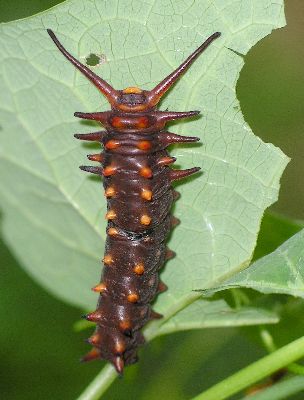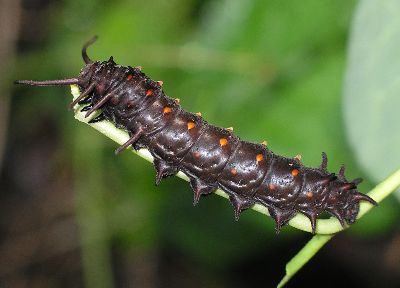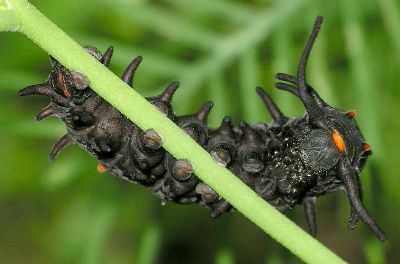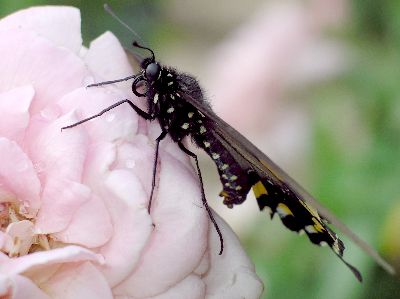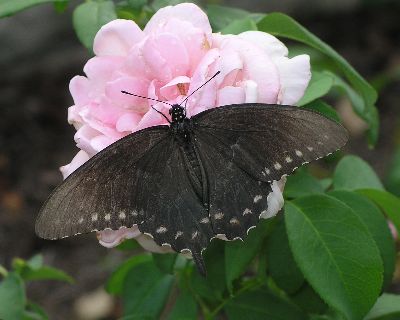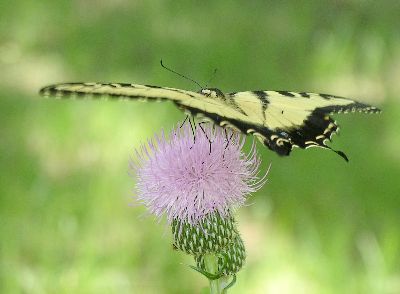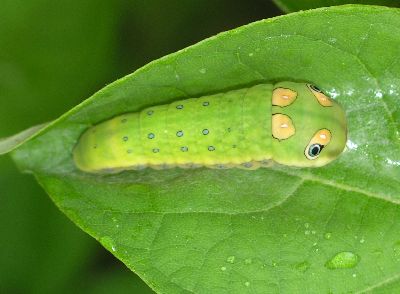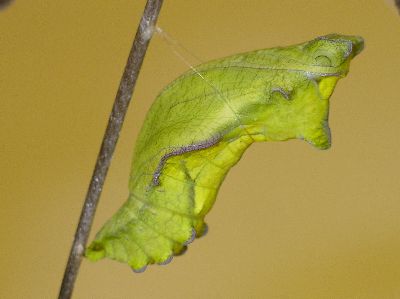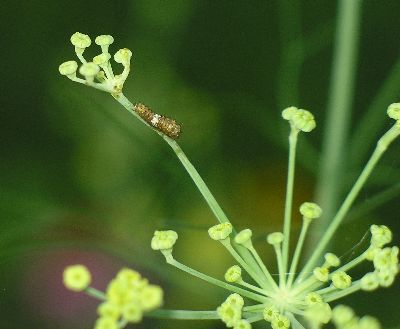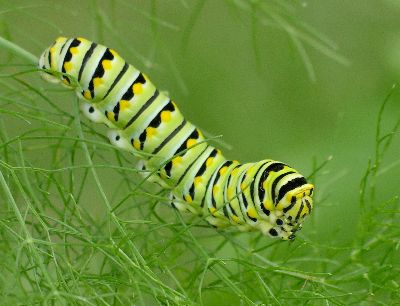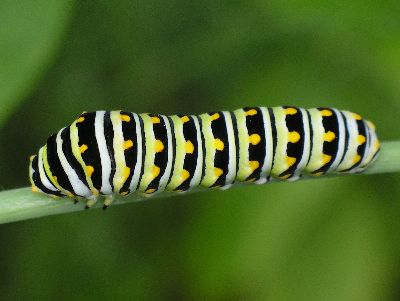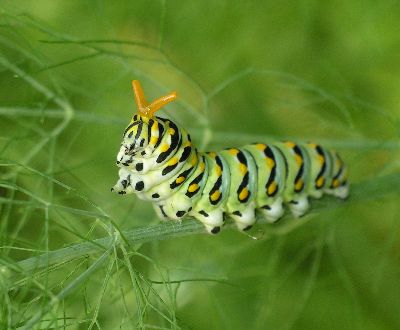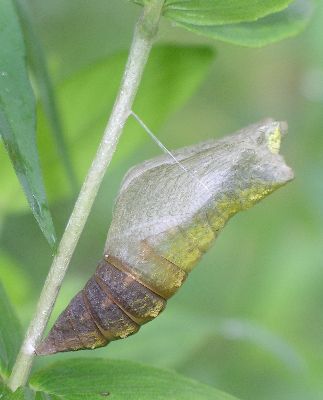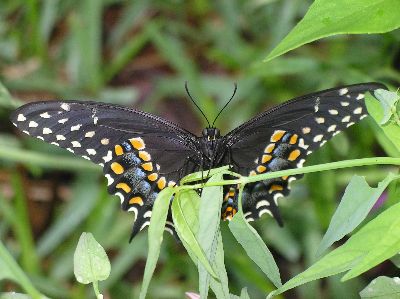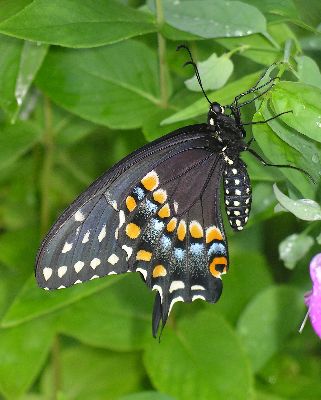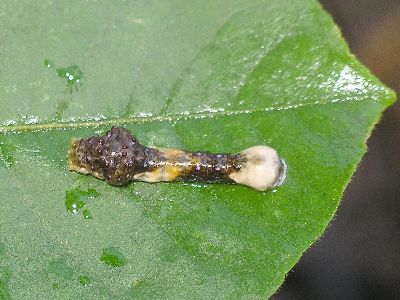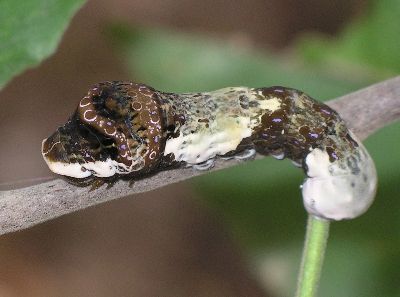The images presented in these galleries are reductions of photos taken by Valerie with a Pentax Optio 450 digital camera. The compression has been increased to 80% (100%=no compression) and the dimensions reduced in order to save bandwidth and facilitate page loading. The information below each image gives the size in pixels and kilobytes of the original file as well as the title by which to request the larger version. All of the original files are in jpeg format, most at about 95% compression, and are suitable for printing, desktop wallpaper, or detailed study. While the images here are free for the taking (right click - save as; do not link to these images directly), the larger versions are also available by sending a request to Valerie via . The frames around the gallery photos are not part of the same file and are only for presentation on this site.
Although the photos are free to use, they are copyrighted by LARVALBUG and remain the property of the owners of this site. We request that any public use of these images be accompanied by a credit to LARVALBUG.COM and, when appropriate, a link to our site (<a href="http://www.larvalbug.com/">LARVALBUG</a>). Commercial use of the large files can be arranged for a modest fee.
To request larger files or ask any questions please send an e-mail to Valerie at .
|
|
Swallowtail Butterflies, family Papilionidae. Our largest and most impressive butterflies belong to this family. We find both larvae and adults in our gardens and in the area around Austin. An article on swallowtails in larvalbug's garden provides detailed information on these butterflies.
Pipevine Swallowtail caterpillar (Battus philenor). I find the caterpillars of this species far more often than the adults. The caterpillars come in two flavors: red and black. This one is red. Any garden with a patch of pipevine, in this case Aristolochia fimbriata, is bound to attract these butterflies.
Another red form pipevine swallowtail caterpillar. All the photos of these larvae were taken at Zilker Gardens, where the caterpillars happily munch the pipevines (Aristolochia fimbriata) to the ground. Of all the swallowtail caterpillars in our area, the pipevine is perhaps the strangest looking, with all the long fleshy tentacles.
Black form pipevine swallowtail caterpillar. These larvae grow fairly large and are easy to spot, especially once they have defoliated the pipevines.
Another black form pipevine swallowtail caterpillar. The food source for these larvae, pipevines of the genus Aristolochia, provide the caterpillars and the resulting adults with toxic compounds, making them unpalatable to birds. Just like with the milkweed butterflies, the pipevine swallowtail caterpillars can feed right out in the open during the day and not fear becoming a meal themselves.
One more black form pipevine swallowtail caterpillar. I find these bizarre larvae to be fascinating and fun to photograph. The pipevines on which they feed are also lovely in their own right, but they are often eaten up pretty badly.
Pipevine Swallowtail Butterfly (Battus philenor). I usually see pipevine swallowtails at a distance and they are very active flyers. This one was still resting in the cool of the morning. It is on a rose in Zilker Gardens, Austin, Texas.
Different view of the same butterfly as above. The only pipevine swallowtails that I've seen resting long enough for me to get close have looked rather battered and worn. Usually, the lower wings are a beautiful iridescent blue, but this individual is either lacking the coloration or, more likely, it is all worn off. Although these butterflies are distasteful to birds, that doesn't mean that the birds won't try eating them. From the various individuals I've seen with tears in their wings, I'd guess that most survive their encounters, but they aren't quite as photogenic anymore.
Tiger Swallowtail Butterfly (Papilio glaucus). This butterfly, along with numerous other insects, was feeding on a common fall-flowering plant called frostweed (Verbesina virginica). Like many swallowtails, the tiger is an active and fast insect so it is hard to get a good photo.
Tiger swallowtail on Texas thistle (Cirsium texanum).
Female Tiger Swallowtail. This is a black form of the usual yellow butterfly. Only the females occur in this form, and it is probably an adaptation to imitate the distasteful pipevine swallowtail. Other swallowtails in our area also mimic the pipevine, including the black and spicebush swallowtails. Some of these other black-colored butterflies are likely to be unpalatable as well, or the number of good tasting black butterflies would turn the odds against the small number that taste bad. Birds would probably then decide it's worth it to chance a bite every time. The butterfly is feeding on nectar from a buddleia, or butterfly bush (Buddleia davidii), in our backyard.
A side view of the same individual as the last photo. If there was any doubt that this is actually a tiger swallowtail, it would be dispelled by this view, in which the stripes can be seen, much like the spots on a black leopard. It is an interesting sight when a yellow male and a black female are involved in their mating flight. They swirl around and around each other, often 15 to 25 feet up.
Spicebush Swallowtail Caterpillar (Papilio troilus). The larvae of this species feed at night and roll themselves up in a leaf during the day. The large imitation eye-spots are quite an impressive display, probably warding off most predators. This individual was photographed at Zilker Gardens in Austin, Texas.
Polydamas Swallowtail Chrysalis (Battus polydamas). This butterfly is normally found farther south, but sometimes ventures into our area. I've never seen it in the wild, but someone at a meeting of the Austin Butterfly Forum brought this chrysalis in for all to view.
Black Swallowtail Caterpillar (Papilio polyxenes). This is a very young caterpillar which still has the early white saddle marking and little spiky spines all over its body. It is feeding on its preferred food plant: fennel.
Mature black swallowtail caterpillar on fennel. We grow fennel in our gardens mainly to feed these delightful caterpillars. They can defoliate a large plant in a matter of days. All is not paradise, though, for the caterpillars. They often fall prey to paper wasps, which have even attacked individuals that I was photographing. Once the caterpillars get this big, though, they are usually safe.
Another black swallowtail caterpillar. This individual has more black than most. The amount of black can vary considerably but the patterns of the larvae are always similar.
Black swallowtail caterpillar with extended osmeterium. A feature shared by all swallowtail caterpillars, this strange forked protuberance is not found on any other kind of butterfly larva. It has a bad smell and is used to ward off attackers. I rarely disturb caterpillars enough to get them to extend this organ, but managed to get this one riled up.
Empty black swallowtail chrysalis. Although this pupa was within inches of where the caterpillars had been feeding earlier, I never saw it until the large adult was fully emerged and allowing its wings to dry. The empty chrysalis shell retained its normal shape.
Black Swallowtail Butterfly (Papilio polyxenes). Nothing is more photogenic than a newly emerged butterfly. An added bonus is that they must remain still while their new wings harden, making them not only beautiful but cooperative as well. The plant on which this one is resting is called foldwing (Dicliptera resupinata).
Another view of the same butterfly.
This view of the black swallowtail shows that it is a female. The males have large yellow spots on all four wings. The coloration of the females is believed to be an advantageous mimicry of the poisonous pipevine swallowtails.
Giant Swallowtail Caterpillar (Papilio cresphontes). This is a young larva, only about 1 inch long. It is resting on a wafer ash leaf (Ptelea trifoliata). If you think it looks a lot like bird poop, your assessment is correct; this is their camouflage. Although older caterpillars lack this feature, the young larva also has prominent bumps on the front part of its body that, seen from the front head-on, look surprisingly like the eyes of a large jumping spider.
Even as a mature caterpillar, the giant swallowtail still looks like a bird dropping. It does have a lovely and intricate pattern, though. Both this individual and the previous one were found in Zilker Gardens.
Giant Swallowtail Butterfly (Papilio cresphontes). The largest butterfly in North America, the giant swallowtail frequently visits our yard, usually in the evening. Several species of swallowtails roost for the night and seem to like a protected, overgrown area. I've seen tiger, giant and thoas swallowtails all do this and would guess it is a pretty common thing for butterflies to do. If they are disturbed, they will fly a short distance and try again. Often, they are very tolerant of a camera flash and can be photographed from only a short distance. This one was resting on Virginia creeper (Parthenocissus quinquefolia) in our backyard just as dusk was falling.
Another Giant Swallowtail. Just like the butterfly in the previous photo, this one was settling in for the night and thus approachable. I saw it in a friend's garden here in Austin. Compared with the individual in the previous picture, it shows some of the variation inherent in these butterflies. The tone of the yellow markings can vary, not only between individuals, but also depending on how old and worn the wings are. It is resting on nandina (Nandina domestica).
|

